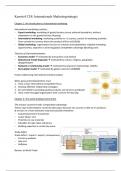Kernstof CE8: Internationale Marketingstrategie
Chapter 1: An introduc2on to interna2onal marke2ng
Interna(onal marke(ng could be…
- Export marke,ng: marke2ng of goods/services across na2onal boundaries, without
adapta2ons to the goods/services (Auping)
- Interna,onal marke,ng: marke2ng ac2vi2es in >1 country, control of marke2ng ac2vi2es
from outside the country where the product will be sold (KLM)
- Global marke,ng: organiza2on focuses on selec2on and exploita2on of global marke2ng
opportuni2es, objec2ve is achieving global compe22ve advantage (Booking.com)
Theories of interna(onaliza(on
- Economic model à mo2vated by transac2on costs (Volvo)
- Behavioural model (Uppsala) à mo2vated by culture, religions, geography
(Doppelmayer)
- Network or rela,onship model à mo2vated by long term rela2onships (ASML)
- Born global model à mo2vated by global customers (AIRBNB)
Factors influencing interna(onal markets (slepts)
When going interna(onal firms must
1. Have a clear interna2onal compe22ve focus
2. Develop effec2ve rela2onship strategies
3. Be commiTed to providing quality products and services worldwide
4. Have a well-managed organisa2on with a culture for learning
Chapter 2: The world trading environment
The reasons countries trade: Compara(ve advantage
Theory says trade between countries takes place because one country is able to it’s products
& services in a more aTrac2ve way than possible elsewhere.
- Sustained period of investment
- Lower labour cost
- Proximity to raw materials
- Subsidies to help na2ve industries
- Building exper2se in certain key areas
Trade deficit
Trade deficit = import > export, consequences
- Currency weakens
- Jobs lost
- Defla2on
Barriers to World Trade
, World ins(tu(ons that foster mul(lateral/free trade
- World Bank (IBRD)
• Currently 189 member countries
• Provides financial and technical help for the development of poorer countries
- Interna2onal Monetary Fund (IMF)
• Currently 189 member countries
• Provides short-term interna2onal liquidity to countries with Balance of Payments
difficul2es
- The WTO - promotes trade by:
• Working to reduce tariffs
• Prohibi2ng import/export bans and quotas
• Elimina2ng trade discrimina2on
• Elimina2ng non-tariff barriers
Chapter 3: Social and cultural considera2ons in interna2onal marke2ng
What is culture?
- Beliefs: A large number of mental and verbal processes which reflect our knowledge and
assessment of products and services
- Values: The indicators consumers use to serve as guides for what is appropriate
behaviour, they tend to be rela2vely enduring and stable over 2me and widely accepted
by members of a par2cular market
- Customs: Overt modes of behaviour that cons2tute culturally approved or acceptable
ways of behaving in specific situa2ons. Customs are evident at major events in ones life
e.g. birth, marriage, death and at key events in the year e.g. Christmas, Easter, Ramadan,
etc.
Hall’s high/low context cultures
Hofstede’s cultural dimensions (6 D’s)
- Individualism (IDV)
• Affects the way people live together
- Power distance (PDI)
• Dealing with human inequality
- Uncertainty avoidance (UAI)
• Managing future uncertainty
- Masculinity (MAS)
• Male / female stereotyping
- Long Term Orienta,on versus Short Term Norma,ve Orienta,on (LTO)
• Tradi2ons and steadfast
- Indulgence versus Restraint (IND)
• Gra2fica2on of human needs, wants and desires





